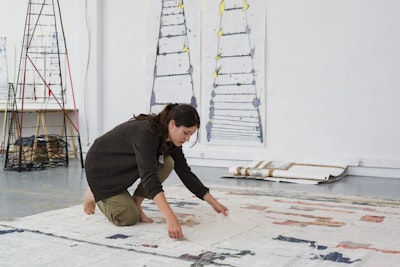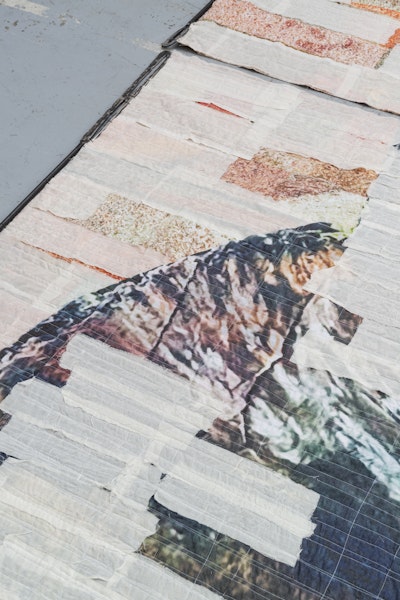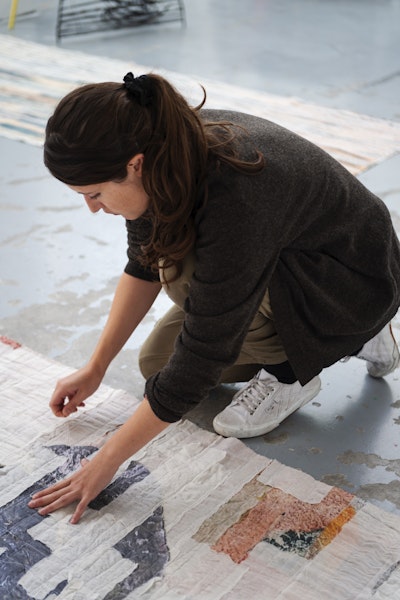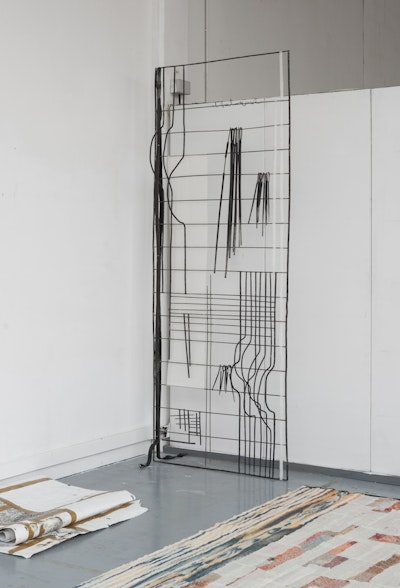The French artist Pauline-Rose Dumas, who took part in the EIB Institute’s Artists Development Programme in 2022/2023, has been commissioned to make new work for the café space at Luxembourg Art Week. Her installation, Café Pauline, continues her research into the combination of wrought-iron sculptures and textile works.
Christophe Gallois: In your statement of intent for the project at Luxembourg Art Week, you mention the term ‘spatial writing’. What does it say about your practice, and more specifically about the way in which you approached the space in which your installation will be presented?
Pauline-Rose Dumas: The idea of spatial writing is linked to my work with wrought iron, which is in turn linked to my work with textiles. Forging is like stretching out a thread and unfurling it in space, like a piece of writing or a drawing. The fact that I burnish the metal reinforces this impression, as its colour is reminiscent of a pencil. In the installation I’ve conceived for Luxembourg Art Week, I’ll be ‘rewriting’ the café space with wrought-iron sculptures and textile pieces in response to the different uses to which the space will be put. My works will inhabit the space like mobile walls, suggesting the idea of movement.
CG: To what extent has the specific function of this space inspired you? The title of your work, Café Pauline, creates a kind of fiction around the space, but it also has an autobiographical dimension.
PRD: Cafés are places full of life, full of people passing through, moving around, talking. Sometimes we dwell in them, taking time to think, to work, to concentrate. I took inspiration from these different dynamics. My installation is made up of shapes that overlap and mingle. Its title suggests a space that extends beyond the exhibition. Above all, it’s a space that I want to be intimate, like a meeting place that invites people to literally enter into my creative practice.
CG: Some of the forms you’ve created evoke the idea of writing, or even of words floating in space.
PRD: These shapes come from my notebooks. I wanted to reconfigure the space by dividing it up using huge notebook pages, which replicate certain motifs from my notebooks: notes, but also scribbles, erasures, things that remain largely unrecognisable. Rather than the meaning, it’s the energy of the words that interests me. Writing becomes drawing. The idea of language and writing could also refer to the way in which, in my work, one form generates another. It’s like words following one another to create a sentence. The forms are intimately linked to each other.
CG: Another key element in your sculptural vocabulary is the line. Rather than straight, the line in your work is organic, it’s alive. It’s the line of the weft that intertwines with a multitude of other lines.
PRD: This conception of the line as the weft derives from my training in textile design. In fabrics, the weft is a series of superimpositions and crossings. It’s all the threads forming the pattern or image. I want to preserve this structure but apply it to my work in a metaphorical way. By trying to follow one by one each intuition, each thread, so that the overall impression of all the works put side by side creates a narrative that sublimates the materials and the individual ideas. For instance, for the large fabric pieces in Café Pauline, I began by collecting photographs of very disparate surfaces or objects. It’s when they are put next to each other that a transformation of known details takes place so as to create the new living space formed by the installation.
CG: So your work with textiles is intimately linked to your work with photographic images.
PRD: Yes, I work mainly with fabrics on which images have been printed. In the photographs I take, my interest focuses on materials. I photograph wallpaper patterns in domestic spaces, roughcast walls, a reflection in a puddle, a tree stump... I then transform these images, exaggerating their features, enlarging them, changing their scale and colours. At the end of the process, one no longer recognises the initial motif but instead enters into the material of the image, into its pixels. This brings us back to the idea of the weft: when you get up close to a tapestry, you see all the threads from which it is made.
CG: You are constantly weaving links between the studio space and the exhibition space. Could you tell us more about your relationship to these two spaces?
PRD: I see the studio as a space where different temporalities mix, where things settle. Some works are on hold, while others are still in the making. Together, they create an organic landscape. The studio is also the place where the works coexist with the tools with which they are created.
CG: These tools are also present as sculptural motifs in many of your works.
PRD: Tools have been in my work since my graduation show at Chelsea College of Arts. There, I exhibited samples of materials and left all the needles in the fabrics. Incidentally, enlarged needles can be found in Café Pauline. I’ve attached them to the lines of ‘notebooks’ in order to draw a parallel with the weave of the fabrics.
CG: The exhibition In Vivo, which you presented in January 2023 at Cité Internationale des Arts in Paris, was emblematic of the links you establish
between the studio and the exhibition space. Its very title suggested the idea of a space for experimentation, of the exhibition as a living place.
PRD: For that exhibition, I worked in the gallery space as if it were my studio. There were finished works, but also elements that were more to do with process: scraps of fabric, preparatory drawings, pieces I had reworked. It was a special project, because I had decided not to open the gallery space, which was very small. You saw the exhibition from the outside. I thought of the space as a showcase and worked on the installation based on the idea that there would be a single point of view.
CG: In this project, as in others, there was also a play with scale. For me, one of the distinctive features of your work seems to be the dialogue you manage to create between different scales, between different viewing distances, between the installation as a whole and the smallest of details. In fact, you also created a series of works that play with this idea of scale, since they take the form of scale models: the Antichambres.
PRD: Before getting on to a new installation, I always start with a model. This allows me to reflect on the work as a whole without thinking about the constraints or physical realities of the space. It’s a space of freedom before I move on to the more concrete and physical problems posed by the sculpture. I like this transition from model to real space, from a miniature space that I can look at from above and an installation in which I’m immersed, in the midst of works that are often taller than me.
CG: To conclude this conversation, we might talk about the concept of transition or passage, which you’ve just mentioned. Your work revolves around a number of ‘passages’: between different scales, between the image and the frame, between two-dimensional and three-dimensional space, between materials – wrought iron, fabric, drawing... Leafing through your portfolio, I came across a word that is often mentioned in the technical descriptions of your work: sublimation. In this particular context, it refers to a particular technique for printing on fabric, but it is also more widely used to describe a change of state: the passage from a solid state to a gaseous state. Something of the order of the unstable, the threshold, the transition...
PRD: All these transitions are indeed important to me. I need to let myself be submerged by certain images that crystallise in my memory and trigger a sense of urgency compelling me to make new work. It’s a process of ‘imprinting’: a shape or an idea works on me and, in turn, prompts me to work on it. On one of the fabric pieces in Café Pauline appears a fairly dark mass. As I was working on it the other day, I was thinking about the coffee grounds on the bottom of white earthenware cups. This image of a deposit contains the idea of something that persists, something that aggregates and ends up providing an incentive for our imagination, which is always trying to make out a form, to find meaning.
Café Pauline - Installation by Pauline-Rose Dumas, in collaboration with Institut français du Luxembourg.



